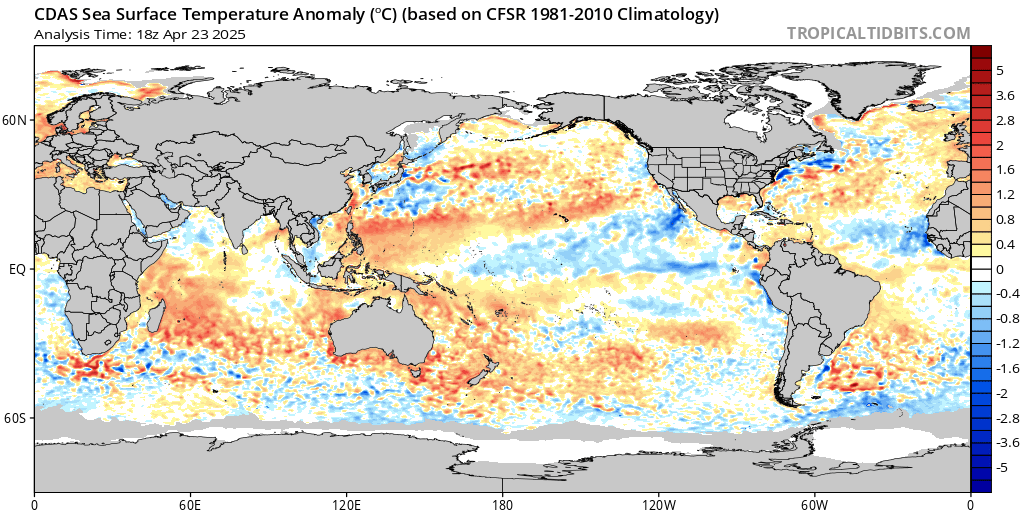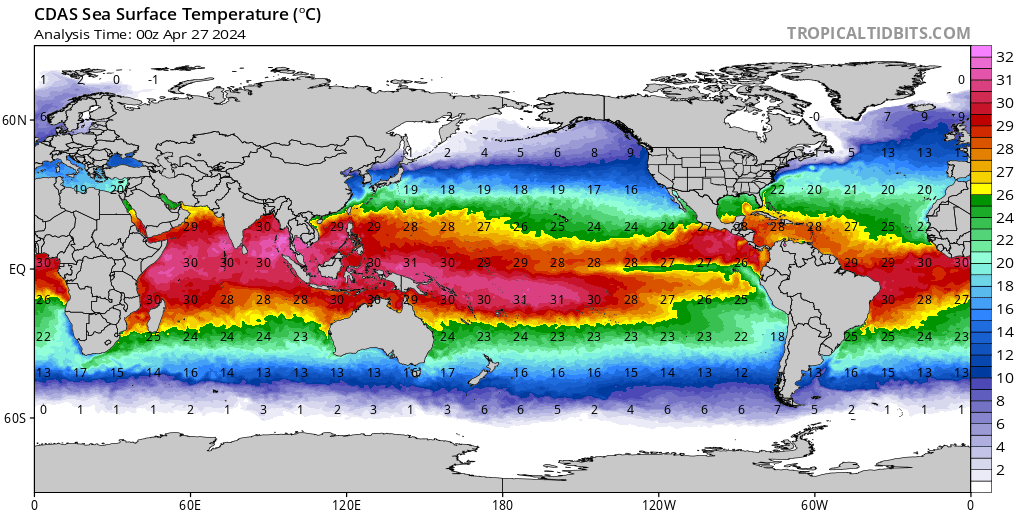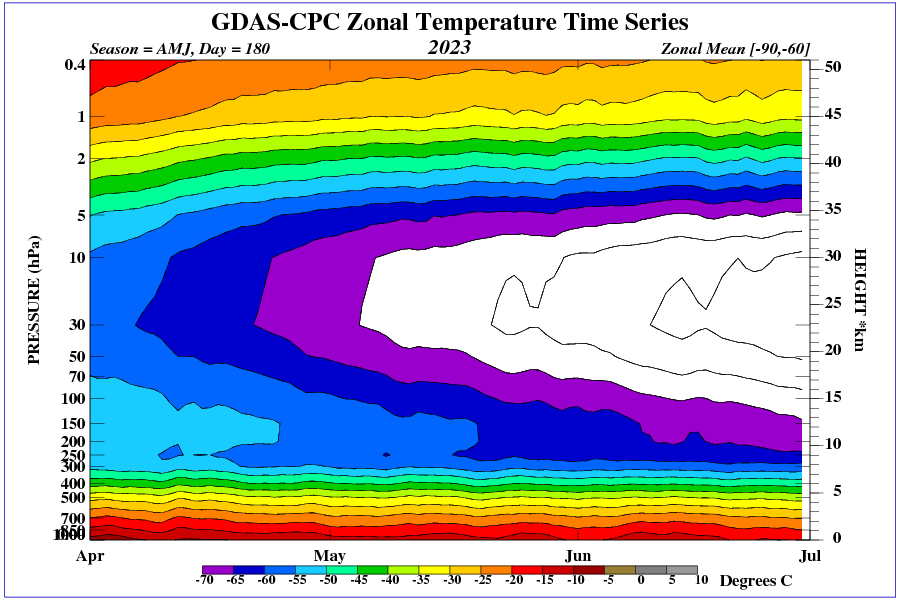By making the official proclamation that El Niño has begun, the National Oceanic and Atmospheric Administration (NOAA) just sent the corporate media into a flurry of doomsday predictions. Who’s fault is it? Ours of course. We blew past the so called 1.5°C limit set by the Paris accord.
On today’s show, we’ll hold up these apocalyptic claims to actual science, looking at historical data as a gauge for the “severity” of modern times. The true story here is that these pundits are fear mongering about a natural event that has happened for millennia.
Join host Anthony Watts as well as expert panelists H. Sterling Burnett and Linnea Lueken for episode 67 of Climate Change Roundtable, live every Friday at 12pm CT/1PM ET.
Watch live here:

The concepts below were from my Sun-Climate and AGU presentations last year.
Over the last few years I’ve shown this graphic depicting an average asymmetrical ~1°C tropical step change from the solar minima to solar maxima and vice versa over the previous nine solar cycles, an up and down sequence which has a probability of occurring of 1.6*10^19 to one, ie, virtually impossible without solar cycle forcing:
This solar cycle is not disappointing, as it’s upward tropical step change has already happened, and it’s not even the solar maximum yet, a sign of the strength of solar cycle #25:
High TSI above my decadal threshold has changed La Niña to El Niño over the last year:
I claimed in my 2022 presentations that the UN 1.5°C ‘limit’ will be breached in the next few years due to high solar cycle #25 activity. Everything climate-wise is happening according to this plan, as the tropics shifted after the 365d sunspot number average exceeded 95, and after the 365d sum of spotless days reached zero last December.
“Scientists are baffled why the oceans are warming so fast”,
I told the science community in 2022 ocean warming would soon go above their 1.5°C ‘limit’.
I told them the real climate tipping point is 95 sunspot number, which we exceeded quickly in this solar cycle; even though it is a below average cycle, it is still capable of dramatic warming.
I told them the threshold between droughts and deluges was 100±6 SN. Since then, high sunspots and TSI has driven more tropical evaporation, and the US drought has subsequently dissipated from the heavy snow and rain deluges driven by higher TSI over the past year.
Bob Weber:
Your explanation for the current Ei Nino warming is incorrect.
It is not due to TSI or sunspot cycles, but is instead due to decreased levels of dimming SO2 levels in the atmosphere, due to Net-zero activities that ban the burning of fossil fuels, with their attendant SO2 aerosol emissions, and a slowdown in global industrial activity.
In other words, this El Nino is man-made. (As also was the 2015-16 El Nino)
Normally, an El Nino is terminated by a VEI4 or greater volcanic eruption, so unless one occurs shortly, temperatures will keep rising. Even then, it takes a year or more for a VEI4 eruption to have its maximum cooling effect, of about 0.2 deg. C.
Also, since the warming is due to a global decrease in SO2 aerosols, the whole world is warming up, causing an El Nino to form. As such, an El Nino does not cause any additional warming, it is simply a result of the warming that has occurred..
If temperatures exceed those of the 2015-16 El Nino (caused by 23 million ton decrease industrial SO2 aerosol emissions), we are in for a REALLY wild ride. See the Wikipedia article on the 2015-16 El Nino weather disasters.
Don’t dismiss this Post out-of-hand!. This El Nino is just a reprise of the 2015-16 El Nino.
I’m sorry Burl Henry to inform you that your proposal is both ignorant and innumerate.
First of all, specifically, what volcanic eruptions ended the 2015/16 El Niño?
The Niño ended at point (i) in the next image, after TSI fell below my sun-ocean decadal warming threshold. The subsequent cooling had nothing to do whatsoever with volcanic eruptions. In my 2018 AGU presentation I predicted solar cooling until SC25 TSI increased to above the decadal threshold, both of which have happened.
The 2015/16 El Niño was caused by TSI being above the decadal warming threshold, depicted by the detrended sum of TSI above the threshold curve from points (f) to (g):
Lastly, increasing TSI via high sunspots is the sole reason the climate warmed.
I used Jim Hansen’s Planetary Temperature Equation (modified Stephan-Bolzmann equation) with a simple PMOD TSI/SN model to determine the exact temperature change in the 30year HadSST3 (representing the climate) over the 109 year period ending in 2010. Changes in greenhouse gases did not change the climate.
High solar activity during the Solar Modern Maximum (1935-2004) caused ‘global warming’, not a lack of volcanic eruptions, or from CO2.
Isn’t it high time you recognize that you have no data to refute this interpretation?
Burl, I will and do dismiss your hand-waving post out of hand. You have no science whatsoever in your favor, all you have is a story-telling type narrative. At the rate you’re going, as my science advances, you will be left behind like the CO2 alarmists.
Bob Weber:
You say that “the Sun controls the temperature ABSOLUTELY” You are absolutely correct, but its intensity at the Earth’s surface varies with the amount of SO2 aerosol pollution in the atmosphere. Decrease it, and it warms up. Increase it, and it cools down. I have graphical data which proves this.
You asked “specifically what volcanic eruptions ended the 2015/2016 El Nino?”
A volcanic eruption does not instantly decrease global temperatures. For a VEI4 eruption it takes, on average, 16 months for its SO2 aerosols to reach its maximum cooling effect.
The 2015/2016 El Nino ended on May of 2016. There were four eruptions which could have contributed to its demise: Kelut, 2014 Feb, Chikurachki, 2015 Feb, Calbuco, 2015 Apr, and Wolf 2015 May. It was followed by a La Nina from Jan 2016-Feb 2017.
You also say “increasing TSI via high sunspots IS THE SOLE REASON THE CLIMATE WARMED”.
I am quoting: Emissions of sulfur dioxide from China’s coal-fired power plants dropped significantly overall after a new national pollution limit took effect in 2014, as shown by data from monitoring instruments at facilities and a NASA satellite”
Because of the Chinese reductions, between 2014 and 2016, global industrial SO2 aerosol emissions fell by 29 million tons, according to gridded data from the Community Emissions Data System (CEDS) of the University of Maryland.
That is an enormous decrease in the amount of SO2 aerosol pollution, and was the actual cause of the 2015/2016 warming. By way of comparison, the 1997/1998 El Nino was caused by a decrease of a reported 7.6 million tons of SO2 aerosols.
So, despite your claims, I DO have data which refutes your interpretations
However, we are in total agreement that CO2 is not responsible any warming. But it is important that the correct cause of the actual warming be established, so that corrective actions, such as abandoning Net-Zero, can be taken.
At 11,053 feet, Mammoth Mountain boasts the highest summit of any California resort, making for deeper, better snow, and beautiful vistas. With 3,500 skiable acres, an average of 400 inches of snowfall, 300 days of sunshine per year, and a season that typically stretches Nov–June, Mammoth delivers big smiles on the slopes from first-timers to Olympians.
The 22/23 winter season is officially our snowiest season on record with over 700″ at Main Lodge and close to 900″ at the summit.
https://youtu.be/2atkBJSwSBk
http://tropic.ssec.wisc.edu/real-time/mtpw2/webAnims/tpw_nrl_colors/namer/mimictpw_namer_latest.gif
The surface temperature of the Southeast Pacific and the Humboldt Current will now steadily decline.


Strong convection west about Central America.
https://www.tropicaltidbits.com/sat/satlooper.php?region=epac&product=ir
Not yet. While 1.5 C has been exceeded several times on daily basis already the threshold is actually in reference to the multi-year average. We still have a ways to go before that happens.
The general trend by UAH has been downward since 2016. It will be interesting to see if this El Nino exceeds the previous peaks or not. Sometime on the next couple of El Ninos, Planck feedback will radiate more heat to outer space and the peaks won’t go as high which will be the start of a multiple decades long cooling trend (of course a risky prediction, but Planck feedback is real and calculably more than CO2, while all the other phenomena such as cosmic rays are fairly unproveable.
As of right now my expectation leans towards no. I show a peak ENSO induced amplification of UAH TLT of 0.34 C in 2016. For the current ENSO cycle I’m only seeing a peak amplification of 0.19 C. Back in 2016 the El Nino was super while in 2023 I’m only expecting a moderate.
The planetary energy imbalance keeps increasing. As of the latest update CERES had it +1.6 W/m2. In 2016 it average about +1.0 W/m2. Assuming whatever radiative force ceases it will take several decades at least before the Planck feedback is exhausted and sustained cooling begins.
Temperatures in the southern hemisphere will now drop rapidly.


Frost in southern Australia and South America can be predicted in advance.
